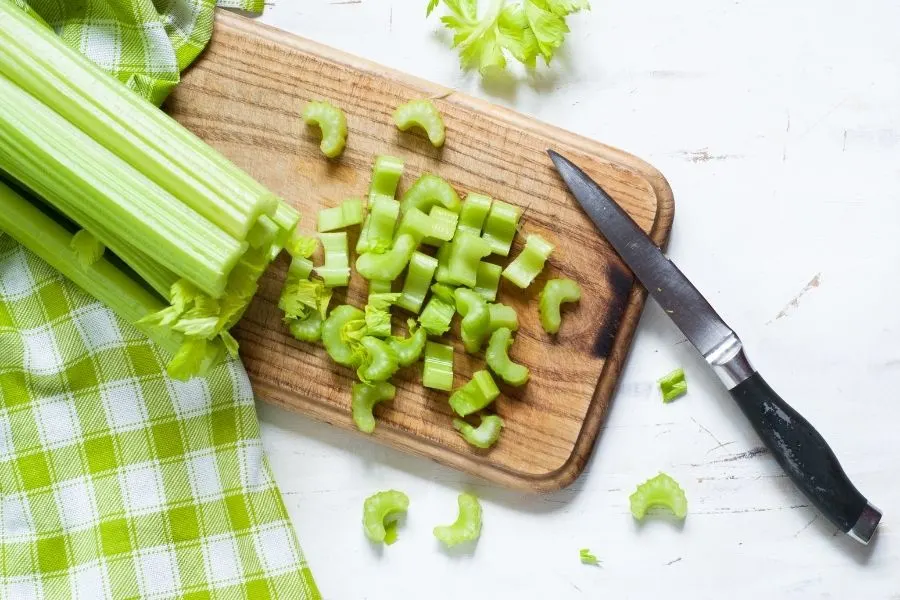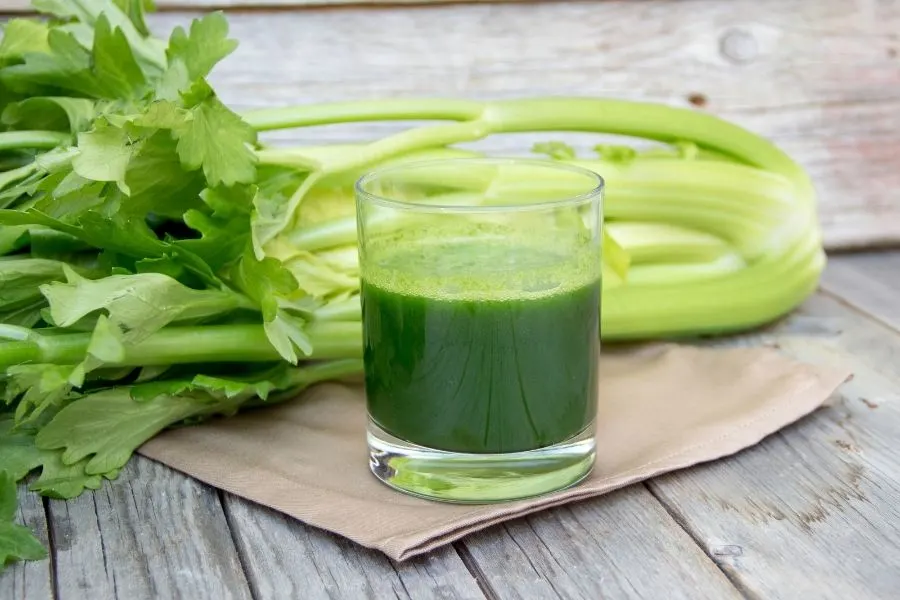When cooking you always have the option of adding spices or herbs your food, and this always adds a ton of flavor. But what about celery leaves ?
Sometimes you add them and they don’t cook through, or maybe you added them to a nice salad.
Can you eat them raw, or do they have to be cooked every time ? And even if they’re cooked, are they still okay to eat ?
This is what we’ll be exploring today, since herbs and spices are not everyone’s forte, and we could all use a little refresher.

Can you eat celery leaves?
Celery has two layers of leaves, both of which are perfectly fine to be consumed raw or cooked. You can add them whole or chop them up small as you would with leafy herbs.
The outer leaves are generally a little chewy and fibrous and fare better in dishes that are cooked so as not to add any unwanted texture. Luckily, they pack the biggest punch—more so than the stalks—so they won’t be overshadowed by the other herbs and spices in a rich stock or broth.
The lighter, inner leaves are more delicate in both flavor and consistency so work well in their raw form as a garnish or added to a salad. Remember that these finer leaves still have a more intense taste than the celery stalks, so don’t throw in too much and overpower your dish.
Celery leaves can be eaten in a variety of ways: they make a delicious addition to salads, soups, and stews with their beautiful, intense flavor, and have the added benefit of being packed full of nutritional goodness.
According to Healthline.com, the majority of the plant’s potassium, calcium, and vitamin C are contained within the leaves.
Read Also:Here’s Why Celery Is So Expensive Lately
How to choose the best celery leaves
If you purchase your celery from a grocery store, then look for a bunch with a good, full cluster of leaves attached.
The leaves should be fresh and crisp and shouldn’t present any brown or yellow patches. If the leaves are discolored, then the flavor and nutritional content will be compromised.
When the leaves show signs of aging, it’s a pretty good indicator that the stalks will be a little bendy and won’t possess that beautiful crunch anymore.
When you get the vibrant, fresh bunch of celery back to your kitchen, select which leaves you wish to use—depending on the type of dish you are preparing—and pinch them off carefully by the stems.
Use the leaves fairly soon after removing them as they will begin to wilt and won’t look very attractive. This is especially important if you’re sprinkling them over soup for example, as it will make your food look a little unappetizing.
If you are removing the leaves in order to prepare the stalks for a recipe, then it is perfectly fine to store them for a later date.
How to store celery leaves
GardeningKnowhow suggests that celery leaves can be treated in much the same way as a herb plant. There’s actually a variety that is grown specifically for cultivating the leaves, rather than uprooting the whole vegetable.
Growing this type of celery at home will allow you to simply remove the greens as-is and when you require them to ensure that your ingredients are always super fresh.
Cut celery leaves can be kept fresh in the refrigerator for up to five days, and much longer if you get them into the freezer soon after removing them. As they are similar in nature to leafy herbs, you should follow the same storage directions. FreshDirect recommends the following:

- To preserve the leaves in a fridge, you should wrap them in a paper towel which should then be placed in a plastic bag in the crisper drawer.
- To freeze your celery leaves, it’s best to finely chop them and keep them in a sealed container. For an extra handy way to have your leaves ready and fresh for cooking at a later date, you can even mince them up small and divide into portions in an ice cube tray. Add a little water and you’ve got yourself a frozen celery stock cube whenever you need it.
What can you make with celery leaves?
The distinctive flavor of celery leaves lends itself perfectly to a whole host of different culinary delights. Here are a few ideas to get you started:
- Risotto. This classic Italian dish can be made using a variety of ingredients. Celery risotto may not be as popular as creamy mushroom, but it’s certainly worth checking out.
- Pot roast. The outer leaves can be braised and stewed in a pot roast to give an intense burst of flavor.
- Pesto. It doesn’t have to just be basil and pine nuts! Celery leaf pesto is an intriguing twist on this popular condiment.
- Salad. One extra delicious salad that you might not have ever considered is chickpea and celery leaf. It’s so easy to make and is really filling too.
- Garnish. People often reach for the parsley when it comes to topping off their soup. Why not try replacing it with the punchy inner celery leaves?
- Soup. Cream of celery leaf and scallion soup. This beautiful soup infused with delicate onion flavors is the perfect way to warm up on a cold winter’s evening.
- Stir-fry. If you’ve never tried it before, then you need to try crispy beef and celery leaf stir-fry. You’ll be left wondering why it’s taken you so long to discover it.
Can you juice celery leaves?
The nutritional content that is packed into celery leaves would certainly make a great addition to your daily detox routine.
Some people find the taste can be a little overpowering as a juice and that the leaves add a slight bitterness. You could opt to use the stalks rather than the leaves, but it obviously comes down to individual preference.

As a slightly more subtle way to get the benefits of celery in liquid form, try blending it together with summer fruits and frozen berries in a delicious smoothie.
There are loads of smoothie recipes that include a burst of flavor from these punchy little leaves, which just goes to show how versatile it really is as an ingredient.
Read Also:What Does Bok Choy Taste Like?
A few health benefits of celery leaves
The celery plant as a whole offers a range of health benefits which include:
- Reducing inflammation. Celery and its seeds contain anti-inflammatory properties that can help reduce the inflammation associated with some chronic diseases.
- Aiding digestion. The high water content and fiber found in celery can help protect the digestive system.
- Protecting cells. High levels of antioxidants help prevent and slow down damage to our blood cells and vessels.
- Maintaining general health. There are many different vitamins found in celery which all play vital roles in keeping us healthy.
As you can see, celery leaves are not just a great way to add flavor to your food, they’re also nutritious ! Make sure you try it next time, whether it’s in food or in a smoothie.
Conclusion
The conclusion is that celery leaves are totally edible and there are quite a few uses for them from which you can choose.
I hope you got your answer from this article about celery leaves and also you found a few new uses for them.

